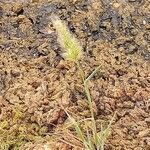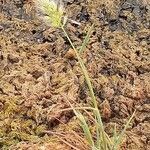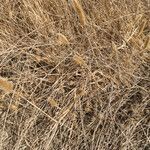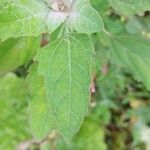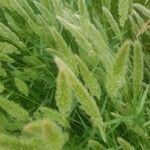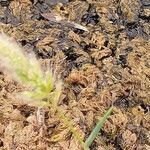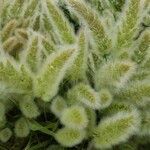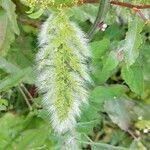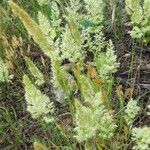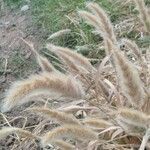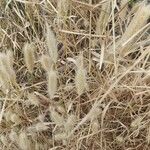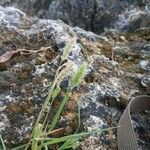Annual, tufted. Culms erect or geniculate, up to 60 cm tall. Leaf blades narrowly to broadly linear, 2–13 cm, 2–9 mm wide, adaxial surface and margins scabrid, abaxial surface smooth, apex acute; ligule 2–8 mm. Panicle narrowly oblong in outline, dense, spikelike, sometimes slightly lobed, 1–10 cm, pale green, thickly clothed in yellow bristles. Spikelets narrowly oblong, 1.5–2.5 mm; glumes narrowly obovate-oblong, puberulous, vein scabrid-aculeate, margins ciliate, apex emarginate, apex of lobes slightly acute, awned from sinus; awn 2.5–4 times as long as glume body; lemma obovate, 1–1.2 mm, apex slightly 4-toothed, midvein extended into a fine, straight, readily deciduous, 1.5–2 mm awn; palea as long as lemma. Stamens 3, anthers ca. 0.8 mm. Caryopsis obovate-oblong, ca. 1 mm. Fl. and fr. May–Oct.
Annual, caespitose. Culms 3–96 cm high, branched or unbranched above. Leaves: basal sheaths minutely scabrous; ligule dentate; blade 1.5–32 cm long, 1.1–11 mm wide, adaxially scabrous. Panicles 0.6–16.5 cm long, dense, with branches concealed by spikelets. Spikelets 1.7–3 mm long. Glumes narrowly obovate, acute, entire or emarginate, awned apically or subapically, keeled above, 1-nerved, ciliolate, scaberulous, with stiff cilia to c. 0.05 mm long on midrib; lower glume 1.7–3 mm long, with awn 3.8–6.8 (–9) mm long; upper glume 1.8–2.6 mm long, with awn 3.8–7.4 (–9) mm long. Lemma elliptic, 2/3 length of glumes, 0.9–1.5 mm long, shortly bifid or minutely 4-toothed; awn sometimes caducous, 1–1.6 (–3) mm long, subapical, straight, not twisted. Palea elliptic, slightly shorter than lemma.
Annual; culms 6–80 cm. high, in small tufts or solitary, erect or geniculate at the base.. Leaf-blades 5–20 cm. long and 2–8 mm. wide, rough; ligule 3–15 mm. long.. Panicle narrowly ovate to narrowly oblong, cylindrical or lobed, 1.5–16 cm. long and 1–3.5 cm. wide, very dense and bristly, pale green or yellowish.. Spikelets narrowly oblong, 2–3 mm. long, falling with a minute piece of the pedicel; glumes slightly notched at the apex, rough with minute points especially in the lower part, minutely hairy on the margins, with a fine straight awn 4–7 mm. long; lemma about half the length of the glumes, smooth, awnless or with an awn up to 2 mm. long.. Fig. 33, p. 99.
Tufted annual, 60-500 mm high; sometimes with creeping culms. Leaf blade 50-200 x 2-8 mm; ligule an unfringed membrane. Inflorescence a dense, narrowly elliptic panicle, sometimes lobed. Spikelets 2-3 mm long (excluding awns), narrowly oblong, ± laterally compressed, falling with glumes and pedicel or part of it; glumes ± equal, longer than spikelet, scabrid on back, margins minutely hairy, awn 4-8(-10) mm long, spreading. Floret 1, bisexual; lemma awnless or with a short awn up to 2.5 mm long, lateral nerves sometimes minutely extended; anther ± 0.5 mm long. Flowering time Sept.-Apr.
Tufted annual 60-500 mm high; sometimes culms creeping. Leaf blade 50-200 x 2-8 mm. Inflorescence dense, narrowly elliptic, sometimes lobed. Spikelet 2-3 mm long (excluding awns), narrowly oblong; glumes scabrid on the back, margins minutely hairy, awn 4-8(10) mm long, spreading; lemma awnless or with a short awn to 2.5 mm, lateral nerves sometimes minutely extended; anther ± 0.5 mm long.
Erect or ascending annual 1–4 dm; main lvs 3–8 mm wide, rather short, scaberulous; infl ovoid-cylindric to cylindric, 2–5 × 1 cm, excluding the awns, tawny at maturity; glumes 2 mm, silky, shortly 2-lobed; awn rough, 3–6 mm; lemma 1 mm, its delicate, fragile awn 0.4–0.7 mm; 2n=28. Native of Europe, established in waste places throughout most of our range, especially southward.
Panicle 1.5-16 cm. long, very dense, spike-like, bristly, cylindrical or often lobed, compact, rarely interrupted, pale-green or yellowish, rarely brownish; branches obliquely ascending to almost appressed to the rhachis, divided from the base.
Annual; up to 0.5 m high. Leaf blades 50-200 x 2-8 mm. Flowers: panicle compacted; spikelets 2-3 mm long; excluding awns; glume with conspicuous awns; awn spreading; 4-8(-10) mm long; lemmas not awned or with short awn up to 2.5 mm long.
Leaf-laminae 2.5-15(20) x 0.2-0.9 cm., lanceolate-linear to linear, tapering to an acute point, usually expanded, flaccid to somewhat rigid, scaberulous along the nerves on both surfaces or smooth on the lower surface.
Annual, up to 0.5 m tall. Leaves linear; ligule an unfringed membrane. Inflorescence an ovoid, contracted, bristly panicle. Spikelets 2-3 mm long, disarticulating as an entire unit; glume awn 4-10 mm long.
Annual, up to 500 mm tall. Leaf blades 50-200 mm long, 2-8 mm wide. Spikelets 2-3 mm long (excluding awns); glume awns spreading, up to 7 mm long; lemmas awnless or with a short awn to 2.5 mm.
Culms 5-75(90) cm. tall, 2-6-noded, erect or ascending from a decumbent base, slender to somewhat stout, simple, glabrous, smooth or sometimes scaberulous towards the panicle.
An annual grass. It forms tufts. It grows 60 cm tall. The leaf blades are 2-13 cm long by 2-9 mm wide. They are rough on the top surface and smooth underneath.
Glumes 1-2 mm. long (excluding the awn), subequal, narrowly oblong, dorsally scabrous, with the obtuse apex minutely 2-lobed; awn 4-7.5 mm. long, scaberulous.
Annual to 50 cm. Leaves linear. Spikelets in an ovoid, contracted, bristly panicle, pale green, glume awns 4-10 mm long, lemma awns to 2.5 mm.
Lemma c. 1/2 the length of the glumes (excluding the awn), broadly elliptic with the apex minutely dentate; awn (if present) 1.5-2.5 mm. long.
Leaf-sheaths longer (the lower) to shorter (the upper) than the internodes, usually loose, glabrous, smooth or scaberulous towards the mouth.
Ligule 3-15 mm. long, oblong, often lacerate, dorsally asperulous.
Differs from Agrostis in the long-awned glumes and dense panicle.
Lateral pedicels rather short, disarticulating about the middle.
A loosely caespitose rather variable annual.
Spikelets 2-3 mm. long (excluding the awn).
Anthers c. 0.5 mm. long, oblong.
Caryopsis c. 1 mm. long.
